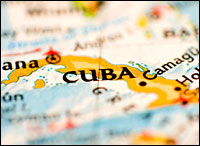
The story is legendary in peak-oil circles: Twenty years ago, the Soviet Union pulled the plug on Cuba’s cheap-energy, cheap-food era. (See Bill McKibben’s feature piece on the subject here.) No longer would the fading superpower accept the tiny island nation’s sugar as payment for crude oil. From then on, only hard currency would do. It also halted food aid. In short order, gas and food prices spiked and people’s living standards tumbled. Next, a widespread shift from cars to bikes, and an explosion in community gardening.
Recently, as our own cheap-energy era appears to be lurching toward its end, the mainstream media have caught wind of the Cuban miracle. Associated Press:
Cuba’s urban farming program has been a stunning, and surprising, success. The farms, many of them on tiny plots … now supply much of Cuba’s vegetables. They also provide 350,000 jobs nationwide with relatively high pay and have transformed eating habits in a nation accustomed to a less-than-ideal diet of rice and beans and canned goods from Eastern Europe.
Note that what’s happening here is something I’m always talking about: small-scale agriculture as not only producer of a diverse food supply, but also as economic engine. And here is CBS News:
Lucky are the Havana residents who live near the organoponico at 44th Street and Fifth Avenue. Occupying nearly an entire city block, it grows a wide variety of vegetables, fruits, and herbs, as well as ornamental plants. It will even sell fresh basil shoots for customers to plant in their own herb garden. On a recent day, customers were offered the following fresh produce at reasonable prices: mangos, plantains, basil, parsley, lettuce, garlic, celery, scallions, collard greens, black beans, watermelon, tomatoes, malanga, spinach, and sweet potatoes.
Luckily for Cubans in general, organic here is not equivalent to expensive. Overhead costs are low. The produce is sold from simple aluminum kiosks, signs listing the day’s offer and prices are handmade, electricity is used only for irrigation, and no transportation other than walking from the raised beds to the kiosks is involved. The result? Everything is fresh, local and available.
CBS reports that of Cuba’s 11 million people, 300,000 directly work in organic farming. That’s 2.7 percent. In the United States, fewer than 2 percent work in farming at all, and only a tiny fraction are organic.
The AP article focuses on a woman who, pre-crisis, had a “solidly middle-class existence” as a research biologist. Now she — quite happily, it seems — scratches out a living as an urban farmer on a half-acre lot.
Neighbors are happy with cheap vegetables fresh from the field. Bouza never lacks for fresh produce, and she pulls in between $100 to $250 a month — many times the average government salary of $19.
Of course, on $100-250 a month, you’re not going to be ponying up for the newest iPhone or jetting off on vacations. For this woman, farming represents a welcome increase in her standard of living: access to fresh, healthy food, and a comparatively good wage.
In other words, consumer capitalism and the Cuban model don’t mix. And indeed, the Cuban government’s embrace of small-scale, neighborhood-level entrepreneurial agriculture may yet prove short-lived. Just last month, government officials announced a partnership with the government of Brazil — the globe’s emerging industrial-agriculture powerhouse — to begin growing soybeans on an industrial scale on the island.

